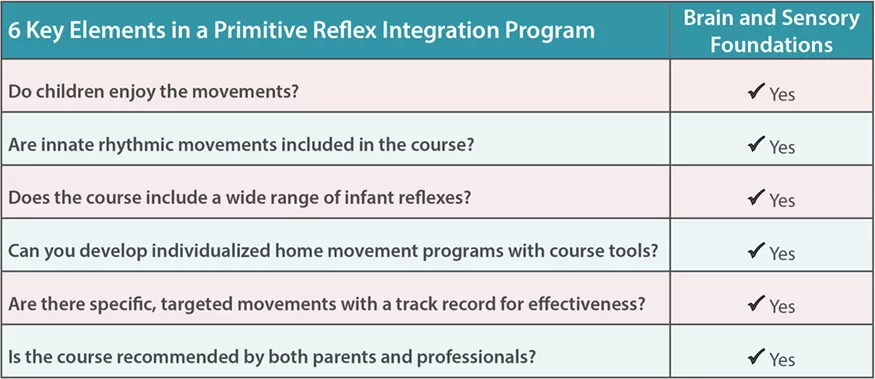6 Essentials for Choosing a Primitive Reflex Integration program
Are you wondering about primitive reflex (PR) programs? Some individuals swear they are helpful, others report they have tried PR programs without seeing results. Reflex integration programs are not all the same.
Find out what combination of elements make for an effective primitive reflex integration program. See the chart here and read more about the 6 Key Elements below.

Your time and resources are valuable. By asking these 6 important questions, you will ensure you are getting the best possible experience and an effective set of tools.
1. Do children enjoy the movements? Play is important! Movements ideally should be relaxing, fun, and enjoyable; otherwise, getting a regular movement program going with a child is like trying to swim against a strong current. With children involved, the focus should be on providing movements that feel safe, inviting, and enjoyable. Adults love these movements too because they find them relaxing, energizing, and great for better sleep and stress release.
2. Are innate rhythmic movements included in the program? In healthy development, the innate rhythmic movements work hand-in-hand with primitive and postural reflexes to drive brain growth. These innate rhythmic movements are excellent for promoting calm, connection, and brain maturity; they are an ideal foundation for helping with sensory processing and reflex integration. Go here to find out why these innate rhythmic movements are critically important for development and reflex integration. If innate rhythmic movements are included in the program, make sure the instructor has in-depth training and qualifications to teach these movements.
3. Does the course include a wide range of infant reflexes? In addition to a wide variety of primitive reflexes, infant postural reflexes are equally important and must be included for best results. Why? Because a full repertoire of infant reflexes is what builds optimal sensory processing and learning. Check out the course outline so you know what is included prior to enrolling!
4. Does the course allow you to develop individualized home movement programs? This is essential because even individuals with the similar challenges can have enormously different needs. Courses with a one-size-fits-all or "recipe" approach may help some, but others are left behind and parents in this situation often end up frustrated. For the best outcomes, choose a program that teaches you assessment and the ability to tailor a movement program that honors the individual child’s pace and capabilities.
5. Are there specific, targeted movements with a track record for effectiveness? The movement patterns of the primitive reflexes themselves do not differ—they look about the same for all infants because they are hard-wired into the human brain. However, there are large differences in the methods used to help integrate the reflexes. We have found that a targeted approach, using the specific sensory input that activates each reflex, plus giving hands-on feedback during the use of the reflex motor pattern is the most effective approach. See over 155 examples of the effectiveness of this approach here.
6. Is the course recommended by both parents and professionals? High ratings are important! If you are going to invest, it is nice to know that others have gone before you and have given the course their whole-hearted endorsement. Hear from a wide variety of professionals and parents about why they love this training.
- Proven track record
- Supported by evidence
- Parents and professionals report that children love the movements
- Excellent outcomes for children and clients of all ages.
Check out comments from many parents and professionals who are thrilled with their experience in the Brain and Sensory Foundations course.
Sonia Story, M.S. has been teaching neurodevelopmental movements since 2006.
She earned a Bachelor's degree in biology/psychology and a Master’s degree in Movement Sciences.
Sonia developed the Brain and Sensory Foundations program to provide comprehensive training in neurodevelopmental movements—combining innate rhythmic movements, play, primitive reflexes, and postural reflexes.
She is the author of The Importance of Reflex Integration and the Evidence eBook, giving the rationale and evidence basis for using neurodevelopmental movements for helping with challenges such as ADHD, Sensory Processing Disorders, anxiety, emotional dysregulation, visual skill deficits, poor social skills, gross and fine motor delays and other neurodevelopmental and behavioral disorders.
Her work is featured in numerous podcasts, summits, and conferences, and in the books Almost Autism: Recovering Children from Sensory Processing Disorder; Special Ed Mom Survival Guide; Family Health Revolution; and Same Journey, Different Paths—Stories of Auditory Processing Disorder.
Sonia’s mission is to help children and families experience the profound benefits of neurodevelopmental and integrative movements for more functional and fulfilling lives.


